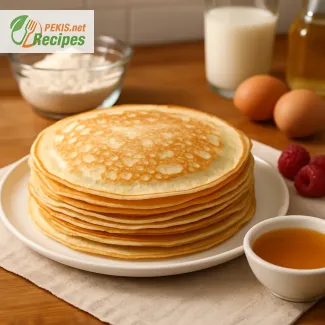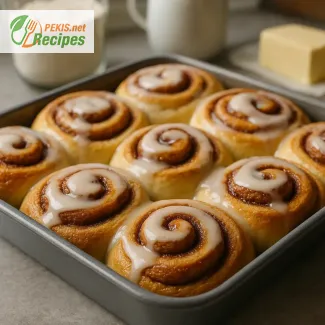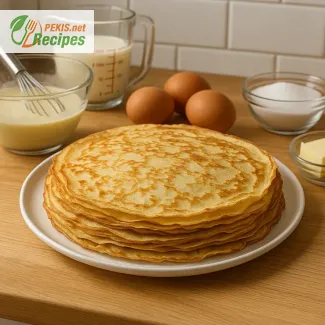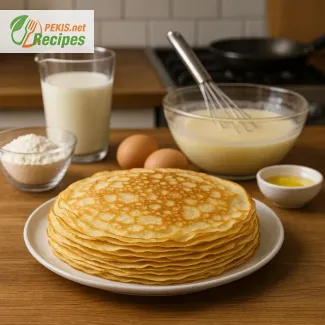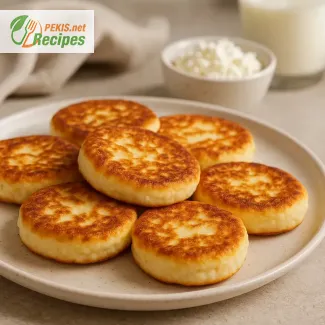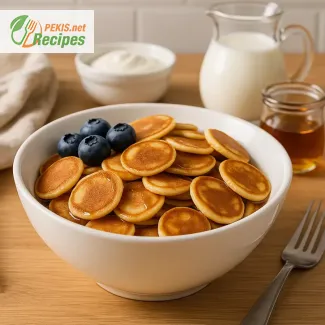Fluffy Rice Flour Pancakes deliver 4 servings in just 25 minutes (prep 10, cook 15). Made with rice flour, milk, and eggs, they’re naturally gluten-free, soft, and perfectly golden with crisp edges. Their light texture makes them ideal for sweet toppings like maple syrup or fresh berries, while remaining gentle on digestion. Store leftovers for up to 3 days in the refrigerator or freeze individually for a quick, wholesome breakfast any day.
PEKIS – professional chef and recipe developer with over 25 years of experience in cooking and baking, specializing in European and international cuisine. I’ve spent years perfecting the balance of texture and flavor in gluten-free creations, and these fluffy rice flour pancakes are one of my favorite weekend treats. I love how the rice flour gives them that naturally soft and airy feel, while the edges stay slightly crisp. Whether you enjoy them plain, with honey, or topped with seasonal fruit, they always bring comfort and lightness to the table.
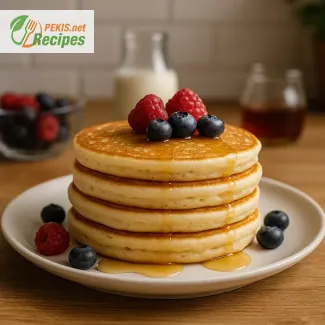
Heavenly Soft Rice Flour Pancakes for a Naturally Light Morning
Discover the Art of Making Fluffy Gluten-Free Pancakes with Rice Flour
Delicate, fluffy rice flour pancakes rise beautifully in the pan, filling the air with a subtle aroma of vanilla and warm milk. Their texture—light yet satisfying—creates a perfect balance between airiness and tenderness, offering an experience that feels almost weightless with every bite. Unlike traditional wheat pancakes, these are naturally gluten-free, making them an excellent option for anyone seeking a softer, lighter, and more digestible breakfast. The use of rice flour brings a uniquely smooth mouthfeel, creating pancakes that are both comforting and elegant—ideal for leisurely mornings or weekend brunches.
When combined with the gentle sweetness of milk, a hint of sugar, and the creaminess of melted butter, the rice flour forms a velvety batter that turns into golden, soft rounds. They cook evenly, without sticking, and develop a slightly crisp edge while remaining fluffy inside. The secret lies in maintaining the right balance of moisture and fat—too little butter and they dry out; too much liquid and they lose structure. This harmony gives the pancakes their distinctive, cloud-like consistency.
The Origins and Evolution of Rice Flour Pancakes
The story of rice flour pancakes stretches back centuries across Asia, where rice has always been a symbol of abundance and nourishment. From Japanese okonomiyaki to Indian dosas and Korean hotteok, various cultures have used rice-based batters to create both savory and sweet versions. As these traditions reached Europe, they merged with local techniques—adding dairy, sugar, and eggs—to develop the European-style rice pancakes known for their soft texture and rich flavor. Today, they have become a global favorite, celebrated for their adaptability and naturally gluten-free base.
In modern kitchens, these pancakes reflect the fusion of simplicity and sophistication. They can be served with fresh fruit, maple syrup, honey, or even savory toppings like smoked salmon and herbs. Their neutral flavor makes them the perfect canvas for both sweet and savory creativity.
Why You’ll Love These Rice Flour Pancakes
- Naturally gluten-free, perfect for a gentle start to the day.
- Fluffy and light, thanks to the unique texture of rice flour.
- Versatile flavor—pair with berries, yogurt, or caramelized bananas.
- Quick to prepare, ideal for busy mornings or brunch gatherings.
- Elegant presentation, with golden edges and a soft, cloud-like interior.
How Rice Flour Shapes the Texture
Rice flour plays a distinctive role in defining the texture of these pancakes. Its fine granularity allows for even hydration, which leads to a smooth, lump-free batter. Unlike wheat flour, it doesn’t form gluten strands, so the pancakes remain soft and airy rather than chewy. When mixed with milk and eggs, the batter traps just enough air to create lift during cooking, giving that signature fluffiness. A small addition of baking powder enhances this rise, while melted butter adds richness and prevents dryness. The result is a pancake that’s both light in texture and rich in taste, ideal for layering with cream, fruit, or chocolate.
Creative Variations to Try
- Coconut Dream: Replace part of the milk with coconut milk and top with toasted coconut flakes.
- Lemon Zest Delight: Add a dash of lemon zest and drizzle with honey for a bright, citrusy morning flavor.
- Savory Spin: Skip the sugar and blend in herbs, grated cheese, or finely chopped spinach for a lunch-worthy version.
- Banana Bliss: Mash ripe bananas into the batter for natural sweetness and a moist, fragrant result.
- Chocolate Indulgence: Add a spoonful of cocoa powder and serve with berries and cream for a dessert twist.
Storage and Make-Ahead Tips
These rice flour pancakes can easily be made in advance. Once cooled, store them in an airtight container in the refrigerator for up to three days. For longer storage, freeze with parchment paper between layers to prevent sticking. Reheat gently in a non-stick pan or toaster for a few minutes on each side—this restores their softness and light golden color without drying them out. The batter itself can also be prepared the night before; just give it a quick whisk before cooking to ensure smoothness.
Related Recipe You Might Enjoy
If you’re inspired by these fluffy rice flour pancakes, you might also love the European-style version:
Thin European-Style Rice Pancakes – Light and Crispy Delight
Semantic Insight: The Harmony of Air, Flour, and Heat
The beauty of fluffy rice flour pancakes lies in the interaction of three key elements—air, flour, and heat. Air provides lift, flour provides structure, and heat locks in that delicate balance, transforming a simple mixture into a golden, tender delight. Each pancake is an expression of precision and simplicity: the fine rice flour binds the moisture, the eggs add elasticity, and the heat seals the batter into a softly set form. Mastering this trio turns an ordinary breakfast into a graceful culinary ritual—one that celebrates texture, balance, and the understated charm of minimal ingredients.
- In a medium-sized mixing bowl, whisk together rice flour, baking powder, sugar, and salt until evenly combined.
- In a separate bowl, whisk the egg, then add milk, melted butter, and vanilla extract. Mix until smooth and slightly frothy.
- Gradually pour the wet ingredients into the dry ingredients, whisking until a smooth, lump-free batter forms. Avoid overmixing to maintain lightness.
- Let the batter rest for 5 minutes to allow the rice flour to absorb moisture.
- Heat a non-stick pan over medium heat (about 180 °C / 356 °F) and lightly brush it with vegetable oil.
- Pour a small ladle of batter (approximately ¼ cup per pancake) into the pan and spread gently.
- Cook until bubbles appear on the surface and the edges start to dry, about 1–2 minutes. Flip carefully and cook another 1–2 minutes until golden brown.
- Repeat with the remaining batter, greasing the pan lightly as needed.
- Serve warm, stacked, with fresh berries (for decoration) and a drizzle of maple syrup or honey (for topping).
FAQ questionAre rice flour pancakes really fluffy without gluten?
Yes—fluffiness comes from lift and moisture balance, not gluten. A combo of baking powder, sufficient liquid-to-flour ratio, and a brief 5-minute batter rest lets rice flour hydrate and trap steam. Cook on medium heat so bubbles set before flipping; you’ll get tender centers with lightly crisp edges.
FAQ questionWhich rice flour works best?
Use finely milled white rice flour for the softest crumb. Brown rice flour adds a light nuttiness but can be slightly denser. Avoid gritty, coarsely ground flours; they resist hydration and yield chalky results. If needed, sift the flour and whisk well with leavening for even dispersion.
FAQ questionHow do I prevent a gritty texture?
Three keys: accurate hydration, a short rest (5–10 minutes) so starches swell, and gentle mixing to keep the batter smooth. If the batter feels thick after resting, whisk in 1–2 tbsp milk to loosen. Cooking on moderate heat ensures the interior sets before the surface over-browns.
FAQ questionCan I make the batter ahead?
Yes—mix and refrigerate up to 12 hours. Before cooking, re-whisk and adjust with a splash of milk if it thickened. The cooked pancakes keep 3 days chilled (airtight) or 1–2 months frozen (layers separated with parchment). Reheat in a dry skillet or toaster to revive soft interiors and crisp rims.
FAQ questionWhy are my pancakes breaking or turning out too dry?
Likely too little fat or liquid, excess heat, or overcooking. Add a touch more melted butter or milk, lower the pan temperature, and flip once when bubbles set and edges look matte. Overmixing can also compact the batter; aim for smooth but not overworked.
FAQ questionWhat are reliable dairy-free or egg-free swaps?
Use unsweetened almond milk or oat milk for dairy-free; replace butter with neutral oil. For egg-free, mix 1 tbsp ground flaxseed + 3 tbsp water (rest 10 minutes) to create a flax “egg.” Expect slightly softer structure; cook a touch longer on the first side.
FAQ questionWhat pan temperature is ideal?
Aim for medium heat—around 180 °C (356 °F) on an electric griddle or a skillet preheated until a drop of water skitters. Too hot scorches the exterior while leaving the center undercooked; too cool yields pale, dense cakes.
FAQ questionHow should I freeze and reheat for best texture?
Cool completely, stack with parchment between pancakes, seal airtight, and freeze. Reheat from frozen in a 200 °C (392 °F) oven for 5–7 minutes or in a dry skillet 1–2 minutes per side. This restores steam-driven softness inside and delicate crispness outside.
Soft, fragrant, and effortlessly satisfying, fluffy rice flour pancakes bring together the best of simplicity and comfort. Every bite reveals a gentle balance between airiness and warmth, with just the right hint of sweetness. The delicate structure of rice flour makes them naturally gluten-free, light on digestion, and perfect for anyone craving a wholesome yet indulgent breakfast.
The beauty of this recipe lies in its versatility. These pancakes can easily adapt to your morning mood—sweet or savory, minimalist or creative. Top them with seasonal fruit, drizzle with maple syrup, or layer with creamy yogurt for extra texture. Each variation enhances their soft interior and golden edges, creating a dish that feels as nourishing as it is elegant.
Beyond taste, they embody the idea of mindful cooking—using simple ingredients to achieve extraordinary texture and consistent results. With only a few pantry staples, you can create pancakes that look and taste like they belong in a café, while being quick enough for a weekday morning. The lightness of the batter ensures that every pancake lifts beautifully, filling your kitchen with the comforting scent of vanilla and butter.
Enjoy them warm, stacked high, and made with care. Whether shared at breakfast, brunch, or as a late-night treat, fluffy rice flour pancakes are proof that even the simplest ingredients can deliver something unforgettable—soft, balanced, and full of quiet joy.
Allergens present in the recipe:
- Eggs
- Milk (dairy)
Contains gluten:
- This recipe is naturally gluten-free, as it uses rice flour instead of wheat flour.
Substitution tips for allergens and gluten:
- Replace milk with almond milk or oat milk for a dairy-free version.
- Substitute egg with flaxseed egg (1 tbsp ground flaxseed mixed with 3 tbsp water, rest 10 minutes) for an egg-free alternative.
- Use coconut oil instead of butter to make it fully plant-based.
- Vitamin B1 (Thiamine): 0.09 mg – supports metabolism and energy production.
- Vitamin B2 (Riboflavin): 0.12 mg – contributes to healthy skin and vision.
- Vitamin B3 (Niacin): 1.5 mg – aids in digestion and nervous system function.
- Calcium: 60 mg – strengthens bones and teeth.
- Iron: 0.6 mg – supports oxygen transport in the blood.
- Magnesium: 15 mg – contributes to muscle and nerve health.
- Potassium: 110 mg – helps regulate fluid balance and heart rhythm.
- Vitamin E: 0.5 mg – protects cells from oxidative stress.
- Polyphenols: 25 mg – promote cellular repair and reduce inflammation.
- Carotenoids (from butter and eggs): 20 µg – support eye health and immunity.
